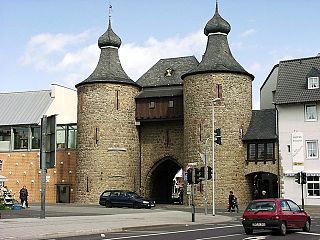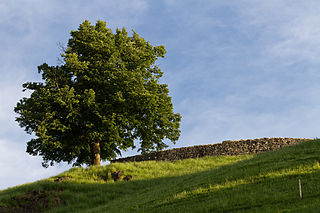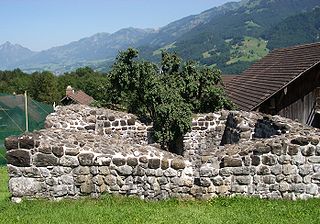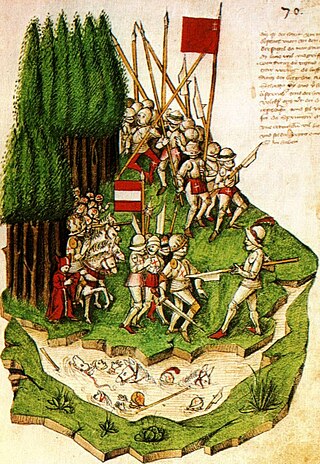
Unterwalden, translated from the Latin inter silvas(between the forests), is the old name of a forest-canton of the Old Swiss Confederacy in central Switzerland, south of Lake Lucerne, consisting of two valleys or Talschaften, now two separate Swiss cantons, Obwalden and Nidwalden.

Obwalden or Obwald is one of the 26 cantons forming the Swiss Confederation. It is composed of seven municipalities and the seat of the government and parliament is in Sarnen. It is traditionally considered a "half-canton", the other half being Nidwalden.

Nidwalden or Nidwald is one of the 26 cantons forming the Swiss Confederation. It is composed of eleven municipalities and the seat of the government and parliament is in Stans. It is traditionally considered a "half-canton", the other half being Obwalden.

The Old Swiss Confederacy began as a late medieval alliance between the communities of the valleys in the Central Alps, at the time part of the Holy Roman Empire, to facilitate the management of common interests such as free trade and to ensure the peace along the important trade routes through the mountains. The Hohenstaufen emperors had granted these valleys reichsfrei status in the early 13th century. As reichsfrei regions, the cantons of Uri, Schwyz, and Unterwalden were under the direct authority of the emperor without any intermediate liege lords and thus were largely autonomous.

Nicholas of Flüe was a Swiss hermit and ascetic who is the patron saint of Switzerland. He is sometimes invoked as Brother Klaus. A farmer, military leader, member of the assembly, councillor, judge and mystic, he was respected as a man of complete moral integrity. He is known for having fasted for over twenty years. Brother Klaus's counsel to the Diet of Stans (1481) helped prevent war between the Swiss cantons.

The Old Swiss Confederacy or Swiss Confederacy was a loose confederation of independent small states, initially within the Holy Roman Empire. It is the precursor of the modern state of Switzerland.
Capital punishment is forbidden in Switzerland by article 10, paragraph 1 of the Swiss Federal Constitution. Capital punishment was abolished from federal criminal law in 1942, but remained available in military criminal law until 1992. The last actual executions in Switzerland took place during World War II.

Murbach Abbey was a famous Benedictine monastery in Murbach, southern Alsace, in a valley at the foot of the Grand Ballon in the Vosges.

Neuhabsburg Castle is a privately owned castle located in Meggen, Lucerne, Switzerland, built on the ruins of a much older castle. In 1244 the income from the land was granted to the Fraumünster Abbey in Zurich. In 1244/5 the original castle was built by the Habsburg family on the shore of Lake Lucerne. The castle may have been built to replace the old Meggenhorn fort. While it may have been the summer home of Rudolph I it mostly served as the administration building for a small Habsburg department that covered Weggis, Lipperswil, Küssnacht, Immensee, Kehrsiten, Greppen, Udligenswil, Arth and Holzhäusern. The castle was damaged in 1245 following the excommunication of Frederick II by Pope Innocent IV at the Council of Lyon. Following the creation of the Old Swiss Confederacy in 1291, the castle was an obstacle to the new Confederation. However, it was not destroyed until 1352, after Lucerne had joined the original Forest Cantons.

The Church of St. Leodegar is a Roman Catholic church in the city of Lucerne, Switzerland. It was built in parts from 1633 to 1639 on the foundation of the Roman basilica, begun in 735, which had burnt in 1633. This church was one of the few built north of the Alps during the Thirty Years War and one of the largest art history rich churches of the German late renaissance period.

Iberg Castle is a ruined castle located on Iberg mountain in the municipality of Riniken in the canton of Aargau in Switzerland. Only a few remnants of the ruins are visible.

Clanx Castle is a ruined castle in the Appenzell District of the canton of Appenzell Innerrhoden in Switzerland.

Witch tower or Witches' Tower is a common name or description in English and other European languages for a tower that was part of a medieval town wall or castle, often used as a prison or dungeon.

The noble family von Sax were a medieval noble family in eastern Switzerland. They owned estates and castles on both sides of the Alps in the modern cantons of St. Gallen, Graubünden and Ticino. The origin of the family is unknown, but they probably stem from Churrätien nobility and were related to the da Torre family. The family divided into two main lines; the Grafen (counts) von Sax-Misox and the Freiherren (barons) von Hohensax.

Rotzberg or Rotzburg is a ruined castle in the municipality of Ennetmoos in the canton of Nidwalden in Switzerland.

Landenberg Castle is a ruined castle atop a hill in the municipality of Sarnen in the canton of Obwalden in Switzerland. In the 18th century an armory and firing range were built on the site. The Landenberg Armory is a Swiss heritage site of national significance. The ruins of the castle was the meeting place of the Landsgemeinde or Cantonal assembly for over three centuries.

Rudenz Castle is a ruined castle atop a hill in the municipality of Giswil in the canton of Obwalden in Switzerland. The castle and surroundings are a Swiss heritage site of national significance.

Rosenberg Castle is a ruined castle in the municipality of Giswil in the canton of Obwalden in Switzerland.

Rhäzüns Castle is a castle near Rhäzüns, Graubünden, Switzerland.




















